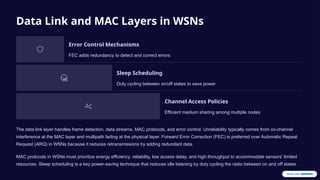Wireless-Sensor-Networks-WSNs-Architecture-and-Applications
- 1. Wireless Sensor Networks (WSNs): Architecture and Applications A Wireless Sensor Network (WSN) consists of devices that gather information from monitored fields and transfer it through wireless links. These networks comprise numerous small, self-directed, low-powered devices called sensor nodes or motes that collect, process, and transmit data to operators. WSNs are designed to monitor physical or environmental conditions such as sound, pressure, and temperature, then cooperatively pass this data through the network to a main location. With computing and processing capabilities, these networks connect to other systems like wireless Ethernet through gateways.
- 2. WSN Network Topologies Star Topology All sensor nodes communicate directly with a central gateway. Simple to implement but limited in scalability and range. Tree Topology Nodes are arranged in a hierarchical structure with the gateway at the root. Offers better scalability than star topology. Mesh Topology Nodes can communicate with multiple other nodes, creating redundant paths. Provides high reliability but increases complexity.
- 3. Types of Wireless Sensor Networks Terrestrial WSNs Deployed on land in predetermined positions or randomly dropped. Typically powered by batteries with optional energy harvesting capabilities. Underground WSNs Buried underground to monitor conditions like soil moisture. Face challenges with signal propagation and battery replacement. Underwater WSNs Deployed in aquatic environments. Utilize acoustic waves rather than radio frequencies due to water's properties. Multimedia WSNs Equipped to capture and transmit multimedia data like images and video. Require higher bandwidth and energy. Mobile WSNs Contain sensor nodes that can move within the environment, allowing dynamic coverage and adaptive monitoring.
- 4. Limitations of Wireless Sensor Networks Limited Storage Capacity WSN nodes possess very little storage capacity – typically only a few hundred kilobytes, restricting the amount of data they can store locally. Modest Processing Power With processing capabilities around 8MHz, sensor nodes can only perform simple computations and data processing tasks. Energy Constraints Nodes require minimal energy and have batteries with finite lifetimes, which constrains protocol design and operational longevity. Communication Limitations Short communication ranges consume significant power, while passive devices provide little energy for data transmission.
- 5. Wireless Sensor Networks Applications Environmental Monitoring WSNs track forest conditions, animal movements, and weather patterns. They enable flood detection, forecasting, and seismic activity prediction through distributed sensing. Military Applications Sensor nodes deployed in fields of interest provide remote surveillance, enemy tracking, and security detection. These networks offer critical intelligence while minimizing human exposure to dangerous environments. Healthcare Monitoring WSNs track and monitor patients and doctors in healthcare settings. They enable continuous vital sign monitoring, medication management, and emergency response systems for improved patient care.
- 6. WSN Architecture Overview Application Layer Software interfaces and data translation Transport Layer Reliability and congestion control Network Layer Routing and data forwarding Data Link Layer MAC protocols and error control Physical Layer Bit transmission and signal modulation WSN architecture follows the OSI model with five layers and three cross-management planes. The layers work together to make sensors operate efficiently, while the cross planes (power, connection, and task management) optimize network performance across all layers.
- 7. Physical Layer in WSNs Core Functions • Frequency selection and carrier generation • Signal detection and modulation/demodulation • Data encryption and decryption Design Considerations • Low power consumption requirements • Limited transmission and reception range • Potential interference from other systems Implementation Challenges • Low complexity requirements • Low duty cycle operation • Variable data rate needs The most challenging aspect in physical layer design is finding low-cost transceivers that consume minimal power while using simple but robust modulation schemes that can provide the required service quality.
- 8. Data Link and MAC Layers in WSNs Error Control Mechanisms FEC adds redundancy to detect and correct errors Sleep Scheduling Duty cycling between on/off states to save power Channel Access Policies Efficient medium sharing among multiple nodes The data link layer handles frame detection, data streams, MAC protocols, and error control. Unreliability typically comes from co-channel interference at the MAC layer and multipath fading at the physical layer. Forward Error Correction (FEC) is preferred over Automatic Repeat Request (ARQ) in WSNs because it reduces retransmissions by adding redundant data. MAC protocols in WSNs must prioritize energy efficiency, reliability, low access delay, and high throughput to accommodate sensors' limited resources. Sleep scheduling is a key power-saving technique that reduces idle listening by duty cycling the radio between on and off states.
- 9. Network and Transport Layers in WSNs Network Layer Functions The network layer's primary function is routing, with challenges including power conservation, partial memory, limited buffers, and lack of universal IDs. Routing protocols define reliable paths according to specific metrics. • Flat routing (e.g., direct diffusion) • Hierarchical routing (e.g., LEACH) Power management at this layer focuses on efficient routing through backbone-based or topology control approaches, allowing some nodes to sleep periodically while maintaining network connectivity. Transport Layer Protocols The transport layer provides reliability and congestion avoidance, with protocols designed for either upstream (user to sink) or downstream (sink to user) communication. • STCP: Provides reliability and congestion control • PORT: Ensures sink receives sufficient information • PSFQ: Reliable, scalable downstream protocol Hop-by-hop reliability is more energy-efficient than end-to- end approaches, making traditional TCP unsuitable for WSNs. Protocols can be packet-driven or event-driven depending on application needs.
- 10. Application Layer and Cross-Management Planes Application Layer Responsible for traffic management and providing software that translates data into understandable forms. Supports various protocols like SMTP, FTP, DNS, and others to enable specific applications across different fields. Power Management Plane Manages power levels of sensor nodes for processing, sensing, and communication activities. Implements strategies to extend battery life and optimize energy consumption across all network operations. Connection Management Plane Handles configuration and reconfiguration of sensor nodes to establish and maintain network connectivity. Ensures robust communication paths despite node failures or environmental changes. Task Management Plane Distributes tasks among sensor nodes to prolong network lifetime and improve energy efficiency. Balances workload to prevent premature node failures and optimize overall network performance.









